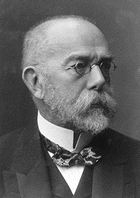Robert Koch was born in 1843. Koch worked on anthrax and tuberculosis (TB) and he further developed the work of Louis Pasteur. Koch’s fame, alongside that of Alexander Fleming, Edward Jenner, Joseph Lister and Pasteur himself, is firmly cemented in medical history.

Koch came from a poor mining family and it took him a lot of determination to get a university place where he first studied mathematics and natural science and then studied medicine.
Pasteur was convinced that microbes caused diseases in humans but his work on cholera had failed. He was never able to directly link one microbe with a disease. Koch succeeded in doing this.
Koch was a doctor and he had a detailed knowledge of the human body – something that Pasteur, as a research scientist – lacked. He was also skilled in experiments, the result of his work in natural sciences. Qualities that also proved to be important were his ability to work for long periods of time and his patience. However, Koch was also difficult to work with and could not tolerate anyone telling him that his theories were wrong.
In 1872, Koch became district medical officer for a rural area near Berlin. He started to experiment with microbes in a small laboratory he had built for himself in his surgery.
The first disease that Koch investigated was anthrax. This was a disease that could seriously affect herds of farm animals and farmers were rightly in fear of it. Other scientists had also been working on anthrax. In 1868, a French scientist called Davaine had proved that a healthy animal that did not have anthrax could get the disease if it was injected with blood containing anthrax. Koch developed this work further and for three years he spent all his spare time finding out what he could about the disease, including its life cycle.
Koch found out that the anthrax microbe produced spores that lived for a long time after an animal had died. He also proved that these spores could then develop into the anthrax germ and could infect other animals.
After this, Koch moved onto germs that specifically affected humans. In 1878, he identified the germ that caused blood poisoning and septicaemia. He also developed new techniques for conducting experiments that influenced the way many other scientists carried out their experiments. He knew that infected blood contained the septicaemia germ but he could not see these germs under a microscope, and therefore, other scientists were unlikely to believe what he thought to be true without the evidence.
Koch discovered that methyl violet dye showed up the septicaemia germ under a microscope by staining it. He also photographed the germs so that people outside of his laboratory could see them.
Koch also devised a method of proving which germ caused an infection. His work was rewarded in 1880 when he was appointed to a post at the Imperial Health Office in Berlin. Here, Koch perfected the technique of growing pure cultures of germs using a mix of potatoes and gelatine. This was a solid enough substance to allow for the germs to be studied better. Koch gathered round him a team of researchers in Berlin in 1881 and began to work on one of the worst diseases of the nineteenth century – tuberculosis (TB).
The TB germ was much smaller than the anthrax germ so the search for it was difficult. Using a more specialised version of his dye technique, Koch and his team searched for the TB germ. In May 1882, Koch announced that his team had found the germ. His announcement caused great excitement. It also generated what became known as ‘microbe hunters’ – a new generation of young scientists who were inspired by the work of both Koch and Pasteur. One of those who was inspired by Koch was Paul Ehrlich.
What was Koch’s legacy? He had finally laid to rest the belief that ‘bad air’ caused disease. He had inspired many other younger researchers to build on his work. He had found the germs of two feared diseases – anthrax and TB. He had developed research techniques that others could use throughout the world.
By 1900, twenty-one germs that caused diseases had been identified in just 21 years. “As soon as the right method was found, discoveries came as easily as ripe apples from a tree.” (Koch) It was Koch who had developed the right methods.